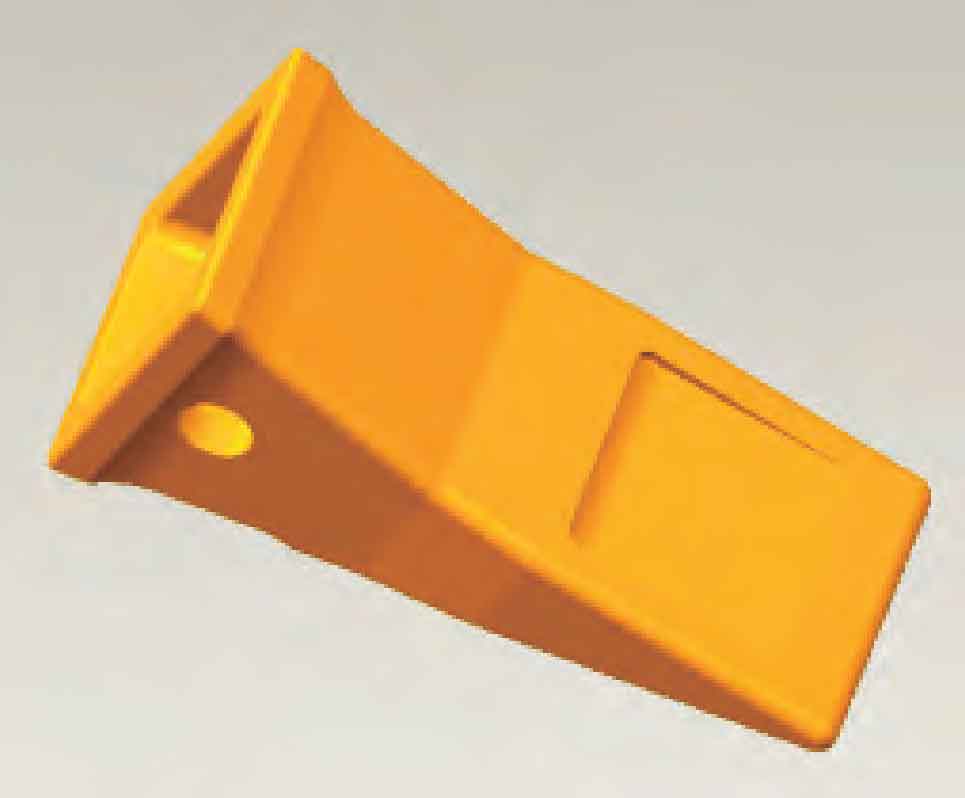With the rapid development of construction machinery, excavator performance continues to improve, driving increased demand for high-strength, high-performance castings with complex shapes. Bucket teeth serve as critical safety components and vulnerable parts in excavators, directly contacting ore materials during excavation operations. These components endure significant impact wear while simultaneously withstanding bending moments, necessitating stringent mechanical property requirements. Our research focuses on optimizing the casting process for P&H2800 high-manganese steel bucket teeth using ProCAST simulation technology combined with practical production methods.
The P&H2800 bucket tooth measures 1340mm × 425mm × 255mm, classifying it as a large casting. Structural analysis reveals symmetrical geometry with reinforcement ribs on both sides of the tooth tip, enhancing component strength while reducing wall thickness to prevent gas defects. For casting sand selection, we conducted comprehensive material testing:
| Sand Type | SiO2 Content (%) | Acid Consumption Value | Refractoriness (°C) |
|---|---|---|---|
| Quartz Sand | ≥90 | 4.7 | 1700 |
| Chromite Sand | ≤3 | N/A | >1800 |
| Olivine Sand | 94 | N/A | >1700 |
The gating system employed bottom pouring design with calculated filling time:
$$ \tau = 1.5 \sim 2.35 \sqrt{G} $$
where G represents casting mass (380kg), yielding an initial filling time of 45s. Initial process parameters included pouring temperature (1600°C) and mold preheating temperature (600°C). ProCAST simulation revealed significant shrinkage defects in the bucket tooth center despite smooth filling:
$$ \phi_{\text{initial}} = 30.86\% $$

Optimization of Casting Process Parameters and Gating System
We conducted single-variable controlled simulations to optimize critical parameters affecting bucket tooth quality:
Filling Time Optimization
Comparative simulations at 35s, 40s, and 50s revealed optimal filling duration:
| Filling Time (s) | Shrinkage Porosity (%) |
|---|---|
| 35 | 30.44 |
| 40 | 28.91 |
| 50 | 29.24 |
The 40s filling time minimized defects while maintaining flow stability.
Pouring Temperature Optimization
Temperature reduction significantly improved bucket tooth quality:
| Temperature (°C) | Shrinkage Porosity (%) |
|---|---|
| 1550 | 27.51 |
| 1500 | 26.13 |
| 1450 | 23.34 |
| 1400 | 23.01 |
1450°C provided optimal balance between fluidity and defect reduction.
Mold Preheating Optimization
Lower preheating temperatures accelerated solidification:
| Temperature (°C) | Shrinkage Porosity (%) |
|---|---|
| 500 | 22.94 |
| 400 | 22.66 |
| 300 | 22.06 |
| 200 | 21.78 |
| 100 | 22.04 |
200°C delivered optimal thermal conditions for the bucket tooth casting.
Gating System Redesign
Despite parameter optimization ($\phi = 21.78\%$), shrinkage persisted. We implemented three modifications: increased sprue diameter (90mm), added two inclined runners with height differentials, and incorporated runner wells at bifurcation points. The redesigned system achieved ideal sequential solidification with complete elimination of internal shrinkage in the bucket tooth ($\phi = 20.08\%$).
Comparison Between Old and New Processes
Thermal analysis revealed significant improvements in cooling behavior. Temperature differential between tooth tip and end reduced from 500°C to 200°C, while solidification time at the riser base decreased by 35%. CAFE modeling predicted grain refinement:
$$ \text{Grain size} = \begin{cases} 170\mu m & \text{(Initial)} \\ 150\mu m & \text{(Optimized)} \end{cases} $$
Mechanical testing confirmed performance enhancements:
| Property | Initial Process | Optimized Process | Improvement |
|---|---|---|---|
| Hardness (HV) | 215 | 235 | 9.3% |
| Wear Loss (mg) | 48.2 | 39.6 | 17.8% |
| Yield Strength (MPa) | 409 | 448 | 9.6% |
Production validation confirmed defect-free bucket teeth with superior surface quality. The optimized process reduces scrap rate by 32% while enhancing product performance, demonstrating significant value for small and medium foundries manufacturing mining equipment components.
